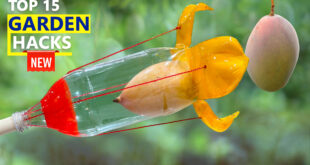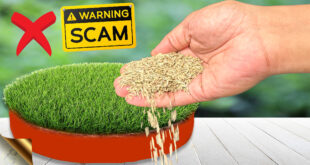In Today’s post, let look into 10 simple tips and tricks to successfully grow citrus trees like lemons, limes or oranges in containers and how to get enormous flowering and fruiting in citrus plants.
Citrus trees are fruit trees and includes lemons, limes, oranges and even grapefruit. These tips are common for those growing citrus either in containers or in ground. Please watch these tips till the end, especially the fertilizer requirement of citrus trees.
Now, Let us look into 10 important tips for growing citrus trees in containers and how to get lots of flowering and fruiting from a single plant.
- CHOOSING THE RIGHT VARIETY: This is obviously the first step in growing citrus trees. You can grow citrus trees from a seed, but you never know the outcome, because seed grown trees are not true to the parent tree and also may not produce fruits or may produce fruits very late. So, the best option is to purchase a grafted citrus tree from a nursery. The plant should start flowering and fruiting the same year, provided you follow all these tips discussed in this episode.
- CHOOSING THE CONTAINER: Minimum size should be 14 inches in diameter and 14 inches in depth and height. The larger the better. You can use good quality plastic pot or a cement pot or even a clay pot if available. You can also grow in barrels like whisky barrels or even plastic drums. Make sure there are a lot of drainage holes at the bottom.
- POTTING SOIL MIX: A well draining soil is very important for proper root growth. A stronger root system will produce a stronger and healthier shoots and yield a good harvest in the end. A simple potting mix formula should include: 40 percent garden soil, 40 percent Coco-peat or peat moss and 20 percent compost like decomposed cow dung or vermicompost. You can optionally add other stuff like perlite, neem cake powder etc if you have. You can watch a detailed post on various potting mix recipes.
Well, In addition to this and to make the root system stronger and induce lots of flowering and fruiting, you can add one handful of steamed bone meal powder which is very inexpensive and easily available. If you are a vegan, you can add organic rock phosphate powder to the potting mix. These two organic fertilizers are very important slow release sources of phosphorous.
- SUNLIGHT: Whether you are growing citrus plant at your balcony or on the terrace, location is very important because citrus trees need full direct sunlight of at least 6 hours for best results. Few important tips to remember here is – when you bring a plant from nursery, do not immediately repot, just keep it in indirect bright light for 3 to 4 days and then repot so that the plant gets time to acclimatize to its new place. Then after repotting, keep it in shade or indirect light for a week to prevent transplant shock. You can also water it once after repotting with Epsom salt water – like 1 teaspoon of Epsom salt per litre of water. This helps fight repotting or transplant shock.
- WATERING: The watering frequency of course depends on the zone you live in or the season of the year. As a general rule in summer, you can water it daily or alternate days. Best practice is to use the finger dip method. Dip one inch of you finger to check for moisture and water only if it’s dry. Over watering can result in root rot and death of the plant. And whenever you are watering, make it a habit to water it deeply and thoroughly so that entire root system is drenched with water and water comes out of the drainage holes.
- FERTILIZERS: This is the most important step, if you want to have lot of flowering and fruiting in citrus trees. Citrus trees are heavy feeders especially during the flowering stage and need a variety of nutrients for healthy fruiting. During fruit formation, if you do not feed them with trace elements like iron, manganese, magnesium and others, they can show signs of deficiency like pale leaves, patchy leaf yellowing depending on the deficiency of the element. You can read a detailed post on various leaf patterns in different nutrient deficiencies and how to rectify them.
First of all, a handful of compost like decomposed cowdung or vermicompost or both every month is the minimum requirement for citrus trees. You can double this frequency or amount in flowering stage. A good quality compost supplies most of the essential macro and micronutrients. If you wish you can add some micronutrient fertilizer containing all trace elements or you can make a cocktail organic fertilizer mixing all available organic fertilizers and calculate its total NPK value, like how I have shown in one of my post on the Universal fertilizer mix.
You supply a source of magnesium – that’s Epsom salt or magnesium sulphate once in 15 days as a foliar spray. 1 tea spoon of Epsom salt per litre of water and spray thoroughly mainly on the underside of the leaves because the stomata or opening for absorption are located more at the underside of the leaves. You can also add banana peel fertilizer once in 15 days to supplement good potassium.
- PEST CONTROL: Citrus trees are occasionally affected by pests like aphids, mealybugs and white flies. Best is prevention by spraying neem oil once in 15 days. 5 to 10 ml neem oil in one litre of water. If its already infested, you can spray weekly once or even twice until all pests are eradicated.
- SOIL PH: Citrus fruit is acidic and many people assume that citrus trees need a very acidic soil ph. But its not true. It need only a slightly acidic soil of around 6 to 6.5 which is the ideal soil PH required for most plants.
- POLLINATORS: This is another important step to promote fruit formation after flowering and prevent flower or bud drop off. Encourage beneficial insects like butterflies and honeybees in your garden which pollinate flowers and encourage fruit formation. Do not spray pesticides particularly chemicals which can drive away these beneficial insects.
- PRUNING: You can regularly trim or prune the unhealthy or dry branches to keep it looking good and you can perform a hard pruning after harvesting or in early spring season.
 GKVKs – Gardening Tips and Store Gardening Tips and Store
GKVKs – Gardening Tips and Store Gardening Tips and Store



